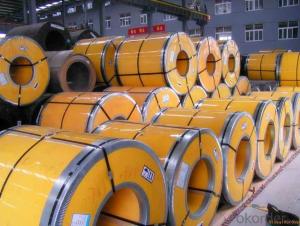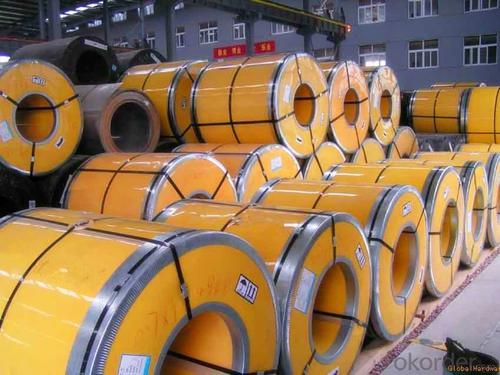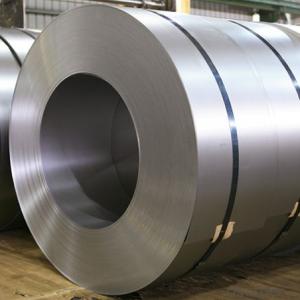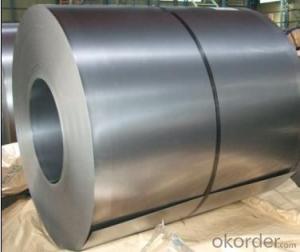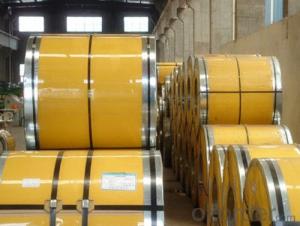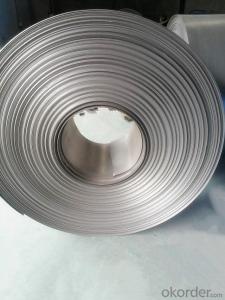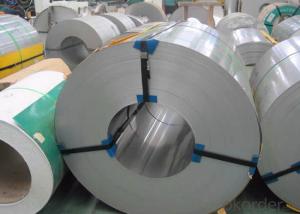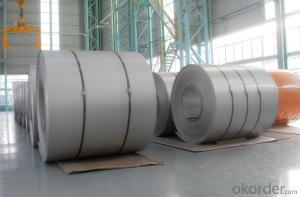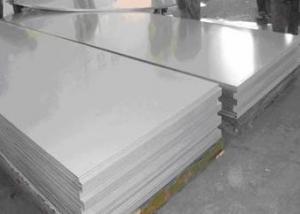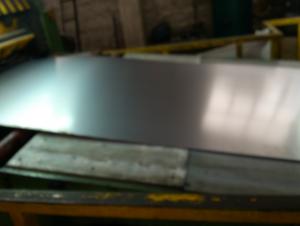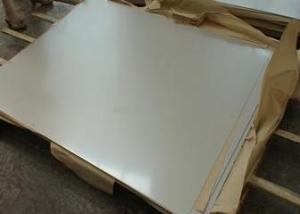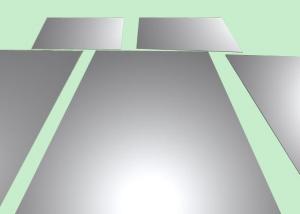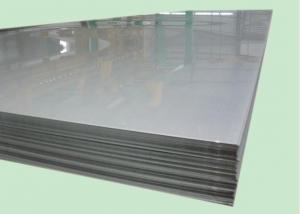304 SERIOUS COLD ROLLED STAINLESS STEEL COILS/SHEETS
- Loading Port:
- Guangzhou
- Payment Terms:
- TT OR LC
- Min Order Qty:
- 100 m.t.
- Supply Capability:
- 20000 m.t./month
OKorder Service Pledge
Quality Product, Order Online Tracking, Timely Delivery
OKorder Financial Service
Credit Rating, Credit Services, Credit Purchasing
You Might Also Like
Quick Details
| Grade: | 300 Series,304 | Standard: | JIS,AISI,ASTM,GB,DIN,EN | Length: | 1000-6000mm |
| Thickness: | 0.3-100mm | Width: | 1000-2000mm | Place of Origin: | foshan |
| Brand Name: | Model Number: | 304 | Type: | Coil | |
| Application: | construction, building, shipbuilding etc | Certification: | SGS | Surface: | 2B,BA,No.1,No.4,HK,Mirror finish,brush ,hairline |
| Producitivity: | 800Tons/Month | Loading Port: | guangzhou | Main market: | india,Japan,Saudi Arabia,Singapore,Indonesia etc |
| Supply status: | cold rolled and hot rolled |
Packaging & Delivery
| Packaging Detail: | standard export packing stainless steel coil grade 304 |
| Delivery Detail: | 7-10 workdays |
Specifications
1,stainless steel coil grade 304
2,Thickness:0.3-100mm
3Width:50-3000mm
4,Length:1000-6000
5,Deliver time:5 days
- Q: What are the different types of surface finishes available for stainless steel strips?
- There are several different types of surface finishes available for stainless steel strips, each offering unique properties and aesthetic appeal. Some of the most common types include: 1. No. 1 Finish: This is a hot-rolled, annealed, and pickled finish that exhibits a rough and dull appearance. It is commonly used for applications where a rough texture is desired or for further processing. 2. No. 2B Finish: This finish is achieved by cold-rolling stainless steel strips and subsequently annealing them in a controlled atmosphere. It results in a smooth, reflective surface that is suitable for general applications requiring a bright and uniform appearance. 3. No. 2D Finish: Similar to the No. 2B finish, this surface finish is achieved by cold-rolling stainless steel strips and annealing them in a hydrogen atmosphere. It provides a slightly duller and less reflective surface compared to the No. 2B finish. 4. No. 3 Finish: Also known as a ground finish, it is achieved by mechanically polishing the surface of stainless steel strips using abrasive belts or brushes. This finish creates a semi-reflective appearance with a linear grain pattern. 5. No. 4 Finish: This is a popular finish for decorative applications, achieved through the use of polishing belts or brushes. It produces a brushed appearance with a consistent grain pattern, providing a satin-like finish. 6. No. 6 Finish: This is a high-gloss finish that is obtained through polishing stainless steel strips with successively finer abrasives. It offers a reflective and mirror-like appearance, making it suitable for decorative applications. 7. No. 7 Finish: Similar to the No. 6 finish, this is achieved by polishing stainless steel strips with successively finer abrasives. However, it is then buffed to create a highly reflective finish with enhanced clarity and depth. 8. No. 8 Finish: Often referred to as a mirror finish, this is the highest level of polish available for stainless steel strips. It is achieved through polishing with extremely fine abrasives, resulting in a flawless, highly reflective, and mirror-like surface. 9. Bead Blasting Finish: This finish is achieved by propelling small glass beads or steel shots at the surface of stainless steel strips. It creates a uniform matte appearance with a slightly rough texture. 10. Electropolished Finish: This is a specialized finish that involves the use of an electrolytic bath to remove a controlled amount of metal from the surface of stainless steel strips. It results in a smooth, bright, and clean finish with enhanced corrosion resistance. These various surface finishes offer a range of appearances and functional properties, allowing stainless steel strips to be utilized in a wide array of applications, from architectural and decorative to industrial and sanitary.
- Q: Are stainless steel strips suitable for architectural mesh?
- Yes, stainless steel strips are generally suitable for architectural mesh due to their durability, corrosion resistance, and aesthetic appeal.
- Q: How do you store stainless steel strips?
- To store stainless steel strips properly, it is important to take certain precautions to prevent damage and maintain their quality. Here are some recommended steps to follow: 1. Clean and dry: Before storing stainless steel strips, make sure they are thoroughly cleaned and dried to remove any dirt, dust, or moisture. This will prevent corrosion or staining during storage. 2. Protect from moisture: Stainless steel is susceptible to rust, so it is crucial to keep the strips away from moisture. Store them in a dry and well-ventilated area, away from any water sources or high humidity environments. 3. Avoid contact with other metals: To prevent potential galvanic corrosion, avoid storing stainless steel strips in direct contact with other metals, especially those that are less noble or prone to corrosion. If stacking the strips, consider using separators or protective layers made of plastic or non-reactive materials to prevent direct metal-to-metal contact. 4. Use proper packaging: To provide additional protection, consider packaging the stainless steel strips in appropriate materials such as plastic wrap, paper, or specially designed corrosion-resistant packaging. This will help prevent scratches, corrosion, or other damage during storage or transportation. 5. Organize and label: Properly organize and label the stainless steel strips to easily identify and retrieve them when needed. This will help prevent unnecessary handling and potential damage caused by searching or mishandling. 6. Temperature control: While not always feasible, maintaining a controlled temperature can help prolong the lifespan of stainless steel strips. Extreme temperature variations can cause expansion and contraction, leading to stress and potential deformation. If possible, store the strips in a temperature-controlled environment. By following these guidelines, you can ensure that your stainless steel strips remain in excellent condition and ready for use whenever needed.
- Q: Can 111 stainless steel strips be used in the automotive industry?
- Yes, 111 stainless steel strips can be used in the automotive industry. Stainless steel is widely used in the automotive sector due to its excellent corrosion resistance, high strength, and durability. The specific grade 111 stainless steel is known for its good formability and weldability, making it suitable for various automotive applications. These strips can be used in the construction of car bodies, exhaust systems, fuel tanks, and other components where resistance to corrosion and high mechanical properties are required. Additionally, the use of stainless steel strips in the automotive industry helps enhance safety, improve fuel efficiency, and reduce overall vehicle weight.
- Q: What are the benefits of using 111 stainless steel strips over other materials?
- There are several benefits of using 111 stainless steel strips over other materials. Firstly, 111 stainless steel is highly resistant to corrosion and oxidation, making it suitable for use in various environments, including ones with high humidity or exposure to chemicals. This resistance ensures that the stainless steel strips have a longer lifespan compared to other materials, reducing the need for frequent replacements and saving costs in the long run. Secondly, 111 stainless steel strips have excellent strength and durability. They can withstand heavy loads and are highly resistant to wear and tear. This makes them ideal for applications that require high strength and reliability, such as construction, automotive, and industrial sectors. Additionally, 111 stainless steel strips offer superior heat resistance. They can withstand high temperatures without losing their structural integrity, making them suitable for applications in extreme temperature conditions, such as in furnaces or industrial ovens. Furthermore, stainless steel is a hygienic material that is easy to clean and maintain. It is non-porous, preventing the growth of bacteria, making it suitable for applications in the food and medical industries. It is also resistant to staining, which ensures a clean and aesthetically pleasing appearance. Lastly, 111 stainless steel strips are versatile and can be easily fabricated into various shapes and sizes, allowing for customization to meet specific project requirements. This versatility makes them suitable for a wide range of applications, from architectural and decorative purposes to structural components. In conclusion, the benefits of using 111 stainless steel strips over other materials include corrosion resistance, strength and durability, heat resistance, hygiene, and versatility. These properties make them a preferred choice in various industries, ensuring longevity, reliability, and cost-effectiveness.
- Q: Can stainless steel strips be used in the pharmaceutical industry?
- Yes, stainless steel strips can be used in the pharmaceutical industry. Stainless steel is a popular material choice due to its high corrosion resistance, durability, and ability to withstand high temperatures and harsh chemicals. It is commonly used for manufacturing pharmaceutical equipment, storage tanks, and process piping to maintain hygienic conditions and prevent contamination in pharmaceutical processes.
- Q: Can stainless steel strips be plated or coated with another metal?
- Stainless steel strips have the capability to undergo plating or coating with another metal. To achieve this, a layer of a different metal is deposited onto the surface of the stainless steel strip. This process serves multiple purposes, such as enhancing appearance, providing corrosion resistance, improving hardness or lubricity, or enhancing electrical conductivity. Various methods can be employed to accomplish the plating or coating, including electroplating, electroless plating, physical vapor deposition (PVD), or chemical vapor deposition (CVD). Each method has its own advantages and limitations, and the choice depends on the desired properties and application requirements. Considerations must be made regarding the compatibility between the stainless steel and the plating or coating material, the thickness of the layer, and the specific environmental conditions the strips will be exposed to. In summary, plating or coating stainless steel strips with another metal is a common practice in numerous industries to achieve desired functional or decorative properties.
- Q: Are stainless steel strips suitable for architectural roof cladding?
- Yes, stainless steel strips are suitable for architectural roof cladding. Stainless steel is a durable and corrosion-resistant material, making it ideal for outdoor applications such as roof cladding. It can withstand harsh weather conditions, including rain, snow, and UV radiation, without deteriorating or losing its aesthetic appeal. Additionally, stainless steel is available in various finishes and colors, allowing architects to choose from a wide range of options to achieve the desired design aesthetic. Its versatility, strength, and low maintenance requirements make stainless steel strips an excellent choice for architectural roof cladding.
- Q: Are stainless steel strips available in different finishes?
- Yes, stainless steel strips are available in various finishes including matte, brushed, mirror, and patterned finishes.
- Q: Are stainless steel strips resistant to scaling and oxidation?
- Stainless steel strips possess resistance against scaling and oxidation. The reason behind this is the abundant presence of chromium in stainless steel, which creates a protective layer on the material's surface. This layer, commonly referred to as a passive film, shields the steel from oxygen in the surrounding air, thereby preventing corrosion and scaling. Moreover, stainless steel incorporates other alloying elements like nickel and molybdenum, which further bolster its ability to resist oxidation and scaling. Consequently, stainless steel strips find widespread application in various sectors, particularly those that prioritize corrosion resistance, such as the production of kitchen appliances, automotive components, and chemical processing apparatus.
Send your message to us
304 SERIOUS COLD ROLLED STAINLESS STEEL COILS/SHEETS
- Loading Port:
- Guangzhou
- Payment Terms:
- TT OR LC
- Min Order Qty:
- 100 m.t.
- Supply Capability:
- 20000 m.t./month
OKorder Service Pledge
Quality Product, Order Online Tracking, Timely Delivery
OKorder Financial Service
Credit Rating, Credit Services, Credit Purchasing
Similar products
Hot products
Hot Searches
Related keywords
